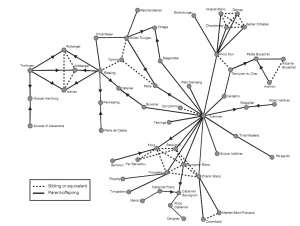Mummies are always trouble. I hate to say it. You see, in my line of work we can do an awful lot with a skeleton. We're usually down to a few pieces of bone, so that a skeleton is an unimaginable luxury.
The typical mummified body carries so much more information than a skeleton. I mean, you've got soft tissue there, whole organs. Food left in the mummy's tummy. With Egyptian mummies, you had a whole crew of embalmers using special techniques to preserve the body. They could not possibly have done more to give us time capsules of human biology from the dawn of history.
So why does it seem like every study of a mummy ends up in a fight?
I think that mummies give too much to chew on. With a bone, it's sort of likely that you only have one indicator of pathology. One symptom makes for a pretty simple diagnostic problem. Sure, you're likely to be wrong, but with one symptom where's the argument?
Now, a whole body -- well, there you'll probably have several symptoms. Or you'll have things you would expect to see with a pathology, but they're just not there. So every armchair paleopathologist ends up with his own theory about what the mummy's got.
The mummies in the news this week are thought to be Akhenaten, Tutankhamen, and their relatives. Last year, Zahi Hawass and colleagues [1] published a paper in the Journal of the American Medical Association, reporting on their Discovery Channel-funded research on these mummies. They ran a series of tests to assess the paleopathology of these mummies, including some work demonstrating the presence of falciparum malaria. They also extracted DNA from the mummies and constructed a pedigree connecting them based on shared microsatellite alleles.
I wouldn't ordinarily write about mummies. They're really not my thing. If there were a Neandertal mummy, well, I'd be all over that. Ain't gonna happen.
But if you follow ancient DNA, that last detail probably gave you a bit of a hiccup. Can we really amplify STR alleles from mummies with any accuracy?
Well, that's why the story is in the news this week. For example, Jo Marchant in New Scientist writes 'Royal rumpus over King Tutankhamun's ancestry', quoting geneticists who question the results. Eline Lorenzen and Eske Willerslev wrote a letter to JAMA pointing out the literature on the topic [2]. There are just so many problems with contamination and DNA degradation, even if you have a large tissue sample to work with. The idea that you could extract DNA and do straight-up PCR amplification to identify microsatellite alleles seems, well, optimistic.
The geneticists involved in the study, Albert Zink and Carsten Pusch, defend their approach in a published reply, as well as in the New Scientist piece.
I'm skeptical. In 2000, Pusch was involved in a study that claimed to extract DNA from Neandertal and early modern human remains, testing their similarity by means of Southern hybridization [3]. That's an even simpler technique, and the published result surprised a lot of people. Cooper and Poinar [4] immediately criticized the study for lacking the proper controls. Shortly afterward, Geigl [5] challenged the result by demonstrating the strength of results could not have emerged among closely-related primate species and likely reflected the presence of soil microorganisms. Considering what we now know about the low endogenous DNA content of ancient skeletal remains, DNA-DNA hybridization just couldn't possibly have gotten any result that wasn't noise.
That's the kind of problem that emerges regularly with ancient DNA studies. When someone is taking an approach outside of the ordinary, they'd better document extremely well their attempts to quantify contamination and present many different approaches to validate their results. At a minimum it is very surprising that mtDNA sequence data were not available with the initial results. The lack of adequate documentation in the Hawass study is why a controversy is arising now.
Can we accurately type STR alleles from mummies? I wouldn't rule it out given the quantity of tissue available, but there should be many more controls for a high-profile study like this one. The work took place over several years, so it's a bit unrealistic to expect the latest sequencing methods. But JAMA and the Discovery Channel presented the results as important science. They should have ensured that solid answers for the obvious questions were at hand.
References
- [Hawass:2010] Hawass, Zahi, et al. '{Ancestry and Pathology in King Tutankhamun's Family}.' JAMA: The Journal of the American Medical Association. 303 (2010): 638-647.
- [Lorenzen:2010] Lorenzen, Eline D., and Eske Willerslev. '{King Tutankhamun's Family and Demise}.' JAMA: The Journal of the American Medical Association. 303 (2010): 2471.
- [Scholz:hybridization:2000] Scholz, M., et al. '{Genomic Differentiation of Neanderthals and Anatomically Modern Man Allows a Fossil–DNA-Based Classification of Morphologically Indistinguishable Hominid Bones}.' The American Journal of Human Genetics. 66 (2000): 1927-1932.
- [Cooper:Poinar:2000] Cooper, A., and H. N. Poinar. '{Ancient DNA: do it right or not at all.}.' Science (New York, N.Y.). 289 (2000).
- [Geigl:2001] Geigl, E. M.. '{Inadequate use of molecular hybridization to analyze DNA in Neanderthal fossils.}.' American journal of human genetics. 68 (2001): 287-291.
